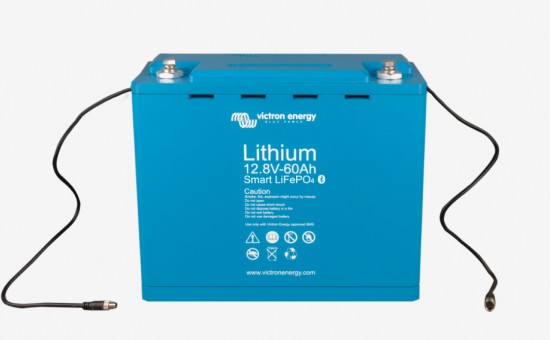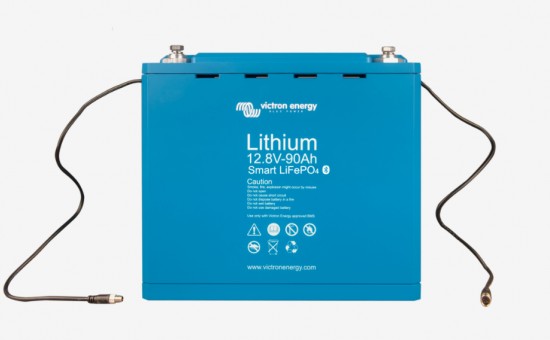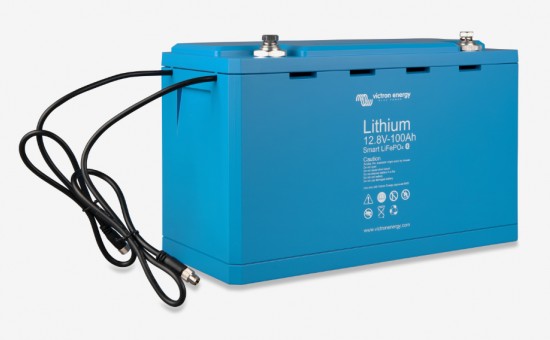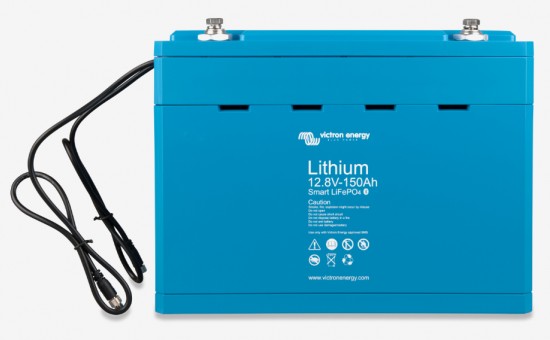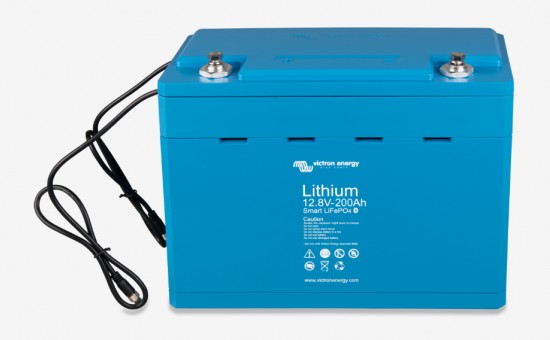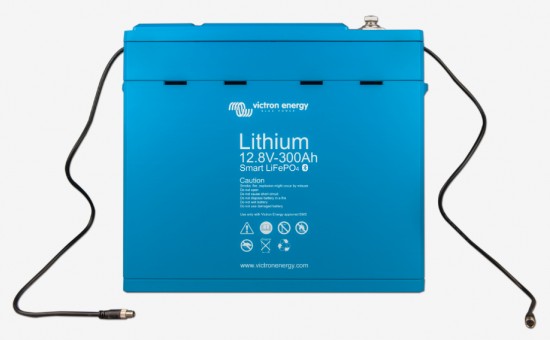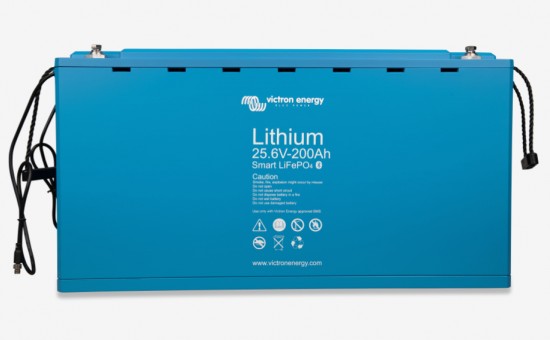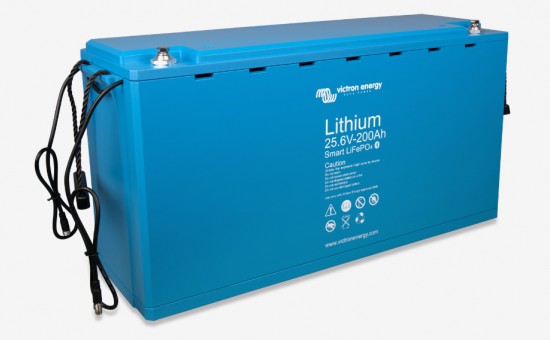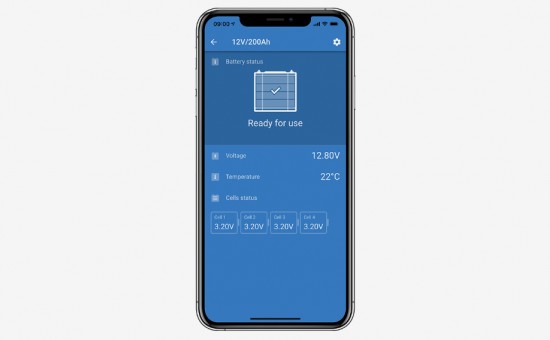LIFEPO4 SMART
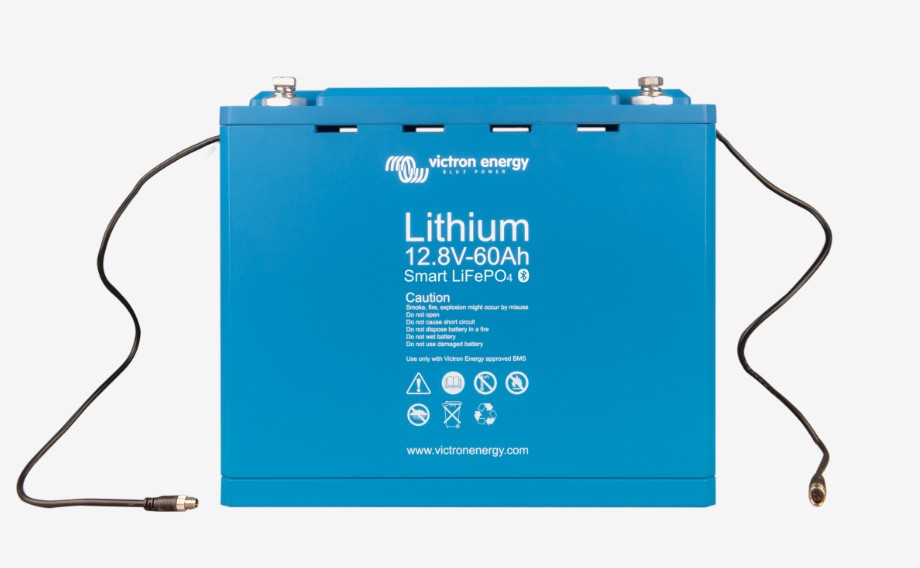
Lithium-iron-phosphate (LiFePO4 or LFP) is the safest of the mainstream li-ion battery types. The nominal voltage of a LFP cell is 3,2V (lead-acid: 2V/cell). A 12,8V LFP battery therefore consists of 4 cells connected in series; and a 25,6V battery consists of 8 cells connected in series.
Rugged
A lead-acid battery will fail prematurely due to sulfation:
- If it operates in deficit mode during long periods of time (i.e. if the battery is rarely, or never at all, fully charged).
- If it is left partially charged or worse, fully discharged (yacht or mobile home during wintertime).
A LFP battery does not need to be fully charged. Service life even slightly improves in case of partial charge instead of a full charge. This is a major advantage of LFP compared to lead-acid.
Other advantages are the wide operating temperature range, excellent cycling performance, low internal resistance and high efficiency (see below).
LFP is therefore the chemistry of choice for demanding applications.
Efficient
In several applications (especially off-grid solar and/or wind), energy efficiency can be of crucial importance. The round-trip energy efficiency (discharge from 100% to 0% and back to 100% charged) of the average lead- acid battery is 80%.
The round-trip energy efficiency of a LFP battery is 92%.
The charge process of lead-acid batteries becomes particularly inefficient when the 80% state of charge has been reached, resulting in efficiencies of 50% or even less in solar systems where several days of reserve energy is required (battery operating in 70% to 100% charged state).
In contrast, a LFP battery will still achieve 90% efficiency under shallow discharge conditions.
Size and weight
Saves up to 70% in space Saves up to 70% in weight
Expensive?
LFP batteries are expensive when compared to lead-acid. But in demanding applications, the high initial cost will be more than compensated by longer service life, superior reliability and excellent efficiency.
Bluetooth
With Bluetooth cell voltages, temperature and alarm status can be monitored. Very useful to localize a (potential) problem, such as cell imbalance.
Our LFP batteries have integrated cell balancing and cell monitoring. Up to 5 batteries can be paralleled and up to four 12V batteries or two 24V batteries can be series connected, so that a 48V battery bank of up to 1500Ah can be assembled. The cell balancing/monitoring cables can be daisy-chained and must be connected to a Battery Management System (BMS).
Battery Management System (BMS)
The BMS will:
1. Generate a pre-alarm whenever the voltage of a battery cell decreases to less than 3,1V (adjustable 2,85-3,15V).
2. Disconnect or shut down the load whenever the voltage of a battery cell decreases to less than 2,8V (adjustable 2,6V-2,8V). 3. Stop the charging process whenever the voltage of a battery cell increases to more than 4,2V.
4. Shut down the system whenever the temperature of a cell exceeds 50°C.
Specifications
| LiFePO4 Smart | Smart 12,8/60 | Smart 12,8/100 | Smart 12,8/150 | Smart 12,8/160a | Smart 12,8/200a | Smart 12,8/300 | Smart 25,6/200 |
| Nominal Voltage | 12,8 V | 12,8 V | 12,8 V | 12,8 V | 12,8 V | 12,8 V | 25,6 V |
| Nominal capacity @ 25ºC* | 60 Ah | 100 Ah | 150 Ah | 160 Ah | 200 Ah | 300 Ah | 200 Ah |
| Nominal capacity @ 0ºC* | 48 Ah | 80 Ah | 125 Ah | 130 Ah | 160 Ah | 240 Ah | 160 Ah |
| Nominal capacity @-20ºC* | 30 Ah | 50 Ah | 75 Ah | 80 Ah | 100 Ah | 150 Ah | 100 Ah |
| Nominal energy @ 25ºC* | 768 Wh | 1280 Wh | 1920 Wh | 2048 Wh | 2560 Wh | 3840 Wh | 5120 Wh |
| Cyce Life ( Capacity ≥ 80% of nominal) | |||||||
| 80% DoD | 2500 cycles | ||||||
| 70% DoD | 3000 cycles | ||||||
| 50% DoD | 5000 cycles | ||||||
| Discharge | |||||||
| Max. continuous discharge current | 120 A | 200 A | 300 A | 320 A | 400 A | 600 A | 400 A |
| Recommended continuous discarge current | ≤60 A | ≤100 A | ≤150 A | ≤160 A | ≤200 A | ≤300 A | ≤200 A |
| End of discharge voltage | 11,2 V | 11,2 V | 11,2 V | 11,2 V | 11,2 V | 11,2 V | 22,4 V |
| Operating Conditions | |||||||
| Operating temperatura | Discharge: - 20 to 50 ºC Charge: 5 to 50 ºC | ||||||
| Storage temperature | -45 to 70 ºC | ||||||
| Humidity | Max. 95 % (non condensing) | ||||||
| Protection class | IP 22 | ||||||
| Charge | |||||||
| Charge voltage |
14 - 14,4 V Recommended 14,2 V |
28 - 28,8 V Recommended 28,4V |
|||||
| Float voltage | 13,5 V | 27 V | |||||
| Maximum charge current | 120 A | 200 A | 300 A | 320 A | 400 A | 600 A | 400 A |
| Recommended charge current | ≤30 A | ≤50 A | ≤75 A | ≤80 A | ≤100 A | ≤150 A | ≤100 A |
| Other | |||||||
| Max. storage time @ 25ºC ** | 1 year | ||||||
| BMS Connection | Male + female cable with M8 circular connector, length: 50 cm | ||||||
| Power connection | M8 | M8 | M8 | M8 | M8 | M10 | M8 |
| Dimensions (h x w x d) mm | 240 x 285 x 132 | 197 x 321 x 152 | 237 x 321 x 152 | 237 x 321 x 152 | 237 x 321 x 152 | 247 x 425 x 274 | 317 x 631 x 208 |
| Weight | 12 Kg | 15 Kg | 20 Kg | 20 Kg | 22 Kg | 51 Kg | 56 Kg |
* Discharge current ≤1C
** When fully charged
Do you want more information about this product?
bornay@bornay.com | (+34) 965 560 025 | Skype


